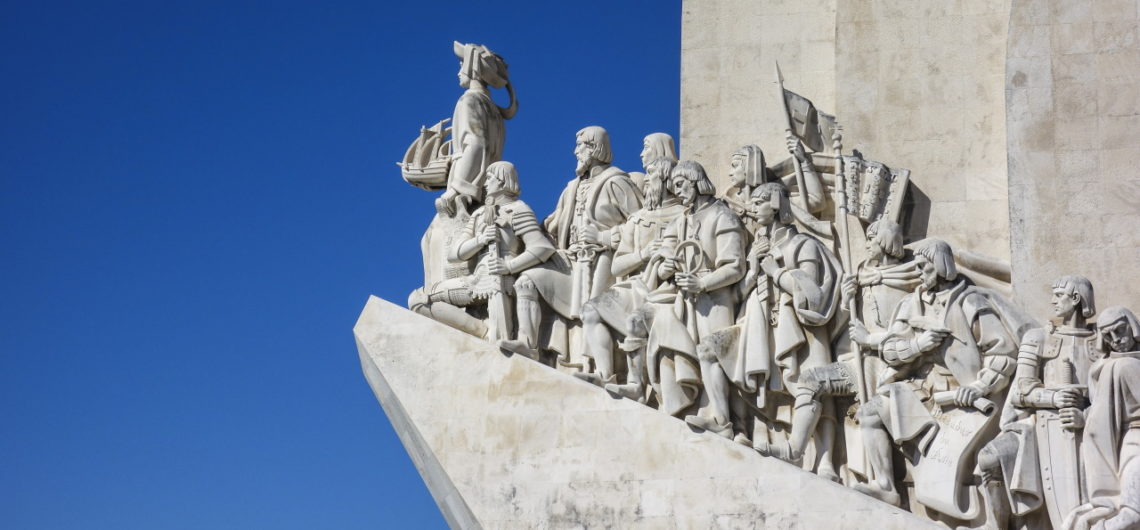Lisbon is an old, layered and complex city, begging for a deep dive to really experience it. Each neighbourhood has distinctive charms, so it’s worth a little advance research to hone in on a personal itinerary. If time is short, any cut-to-the-chase picks to get a real sense of the city would have to include these places:
Praça do Comércio, also known as Terreiro do Paço, is a large plaza at the base of the Baixa commercial district that opens out from the enormous triumphal Rua Augusta Arch down to the river. Surrounded on three sides by old arcaded buildings, this was the nervological center of Lisbon for centuries, so much so that it the home of Lisbon Story Centre, an interactive experience that traces the history of Lisbon (and thus Portugal) through events that took place in this square. It’s a fun way (also suitable for children, with audio guides just for them) to get an overview, and small enough that you don’t spend all day inside.
On the river side of Praça do Comércio the recently renovated old boatyard Ribeira da Naus is a great place to relax by the river and enjoy the sunset. This might seem frivolous, but it is impossible to overstate the importance of the Tagus River to Lisbon. It is fundamental to the history of the city but also to the distinctive light, pace, air and views that are its essence. If you’re only here for a short time, just keep looking towards the water.
Go to Belém. The name means Bethlehem in Portuguese, and it is a condensed area of iconic monuments. The 16th-century Jerónimos Monastery is at its heart. Built to celebrate the discovery of the lucrative sea route to India, details throughout allude to the far-flung places those ships reached. It holds the elaborately carved tombs of Portugal’s greatest explorer (Vasco da Gama) and greatest poet (Luís Camões), who documented that golden age of exploration. It is a prime example of the Portuguese gothic Manueline architectural style, characterized by nautical motifs, such as carved stone ropes. If there is one place that really captures the very heart of Portuguese history, this is it. The monastery is surrounded by other important sites, particularly Belém Tower, a symbol of Lisbon, which saw caravels sail past on their way out to map the world. The Monument to the Discoveries faces the water like the prow of a ship and is lined on both sides with statues of the most important figures from that time. Prince Henry the Navigator, who started it all, is at its head. The pavement in front of it has a massive cobblestone mosaic of a compass rose with a map of the world tracing the Portuguese voyages.
The monastery sits next to the solid bulk of the Belém Cultural Center, built to house the first Portuguese European Presidency in 1992. Made of rosy, rough hewn Portuguese limestone, it looks like a modern castle. From its rooftop garden there are splendid views of the city and the Tagus River. Also nearby is the Pastéis de Belém bakery, where the famous pastel de nata pastry originated. (This is the only place where they can officially be called pasteis de Belém instead.) This area is also home to the popular National Coach Museum, which houses a surprisingly fantastic collection of horse-drawn carriages. While you’re there, plan a stop at Adega Belém Urban Winery to get a crash course in Portuguese wine-making and taste both the liquid delights and some typical snacks.
Finally, although Time Out Market is touristy, it gathers a selection of authentically top restaurants, chefs and products together under one roof. A tasty wander through gives a comprehensive overview of what makes this city a food-lover’s destination, and ideas of restaurants to try for a deeper experience. And for a taste of Lisbon’s cool rooftop bar scene, the nearby Javá Rooftop buzzes from morning ‘til night with fun food and yummy cocktails.
Lisbon has so much to discover, perhaps now more than ever. The city is blossoming and growing in every direction, but this tiny handful of places give visitors a closer look at its roots.
Many of Terracotta Journeys’ tours depart from Lisbon. For example, the Portugal Coastal Hiking tour, the easy walking Discover the Heart of Portugal, the Portugal & Spain Bike tour and the Costa Azul to the Algarve Bike tour.
By Holly Blades

